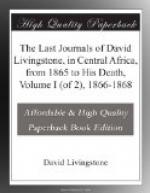17th February, 1867.—Too ill with rheumatic-fever to have service; this is the first attack of it I ever had—and no medicine! but I trust in the Lord, who healeth His people.
18th February, 1867.—This cow we divided at once. The last one we cooked, and divided a full, hearty meal to all every evening.
The boom—booming of water dashing against or over the rocks is heard at a good distance from most of the burns in this upland region; hence it is never quite still.
The rocks here are argillaceous schist, red and white. (Keel, Scottice.)
19th February, 1867.—Chitapangwa begged me to stay another day, that one of the boys might mend his blanket; it has been worn every night since April, and I, being weak and giddy, consented. A glorious day of bright sunlight after a night’s rain. We scarcely ever have a twenty-four hours without rain, and never half that period without thunder.
The camwood (?) is here called molombwa, and grows very abundantly. The people take the bark, boil, and grind it fine: it is then a splendid blood-red, and they use it extensively as an ornament, sprinkling it on the bark-cloth, or smearing it on the head. It is in large balls, and is now called mkola. The tree has pinnated, alternate lanceolate, leaves, and attains a height of 40 or 50 feet, with a diameter of 15 or 18 inches finely and closely veined above, more widely beneath.
I am informed by Abraham that the Nyumbo (Numbo or Mumbo) is easily propagated by cuttings, or by cuttings of the roots. A bunch of the stalks is preserved in the soil for planting next year, and small pieces are cut off, and take root easily; it has a pea-shaped flower, but we never saw the seed. It is very much better here than I have seen it elsewhere; and James says that in his country it is quite white and better still; what I have seen is of a greenish tinge after it is boiled.
[Amongst the articles brought to the coast the men took care not to lose a number of seeds which they found in Dr. Livingstone’s boxes after his death. These have been placed in the hands of the authorities at Kew, and we may hope that in some instances they have maintained vitality.
It is a great pity that there is such a lack of enterprise in the various European settlements on the East Coast of Africa. Were it otherwise a large trade in valuable woods and other products would assuredly spring up. Ebony and lignum vitae abound; Dr. Livingstone used hardly any other fuel when he navigated the Pioneer, and no wood was found to make such “good steam.” India-rubber may be had for the collecting, and we see that even the natives know some of the dye-woods, besides which the palm-oil tree is found, indigo is a weed everywhere, and coffee is indigenous.]
FOOTNOTES:
[36] In coming to cross roads it is the custom of the leader to “mark” all side paths and wrong turnings by making a scratch across them with his spear, or by breaking a branch and laying it across: in this way those who follow are able to avoid straying off the proper road.—ED.




